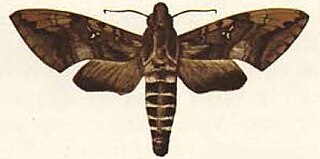
The Sphingidae are a family of moths (Lepidoptera) called sphinx moths, also colloquially known as hawk moths, with many of their caterpillars known as “hornworms”; it includes about 1,450 species. It is best represented in the tropics, but species are found in every region. They are moderate to large in size and are distinguished among moths for their agile and sustained flying ability, similar enough to that of hummingbirds as to be reliably mistaken for them. Their narrow wings and streamlined abdomens are adaptations for rapid flight. The family was named by French zoologist Pierre André Latreille in 1802.

Agrius convolvuli, the convolvulus hawk-moth, is a large hawk-moth. It is common throughout Europe, Asia, Africa, Australia and New Zealand, partly as a migrant. In New Zealand, it is also known as the kumara moth, and in the Māori language as hīhue.

Daphnis nerii, the oleander hawk-moth or army green moth, is a moth of the family Sphingidae. It was described by Carl Linnaeus in his 1758 10th edition of Systema Naturae.

Hemaris tityus, the narrow-bordered bee hawk-moth, is a moth of the family Sphingidae which is native to the Palearctic.

The Sphinginae are a subfamily of the hawkmoths (Sphingidae), moths of the order Lepidoptera. The subfamily was first described by Pierre André Latreille in 1802. Notable taxa include the pink-spotted hawkmoth, being a very common and recognizable species, the death's-head hawkmoths of Silence of the Lambs fame, and Xanthopan morganii with its enormous proboscis.

The Macroglossinae are a subfamily of Sphingidae moths in the order Lepidoptera. The subfamily is divided into three tribes: Dilophonotini, Macroglossini and Philampelini.
Benjamin Preston Clark, known to friends as "Preston", was an American entomologist who specialized in Lepidoptera, especially Sphingidae. He also operated a mercantile business and patented a new form of twine for binding grain.

Hemaris fuciformis, known as the broad-bordered bee hawk-moth, is a moth of the family Sphingidae.

Marumba quercus, the oak hawk-moth, is a moth of the family Sphingidae. The species was first described by Michael Denis and Ignaz Schiffermüller in 1775.

Acherontiini is a tribe of moths of the family Sphingidae.

Sphingini is a tribe of moths of the family Sphingidae. The tribe was described by Pierre André Latreille in 1802.

Ambulycini is a tribe of moths of the family Sphingidae first described by Arthur Gardiner Butler in 1876.

Smerinthini is a tribe of moths of the family Sphingidae. The genus was erected by Augustus Radcliffe Grote and Herbert C. Robinson in 1865.

Sphingulini is a tribe of moths of the family Sphingidae. The tribe was described by Walter Rothschild and Karl Jordan in 1903.

Dilophonotini is a tribe of moths of the family Sphingidae described by Hermann Burmeister in 1878.

Philampelini is a tribe of moths of the family Sphingidae.

Macroglossini is a tribe of moths of the family Sphingidae described by Thaddeus William Harris in 1839.

Platysphinx stigmatica is a moth of the family Sphingidae. It is known from forests from Nigeria to the Congo, Angola and western Uganda.

Nephele peneus is a moth of the family Sphingidae. It is known from forests and woodland from Senegal to East Africa, Angola and Delagoa Bay.

Nephele accentifera, the accented hawk, is a moth of the family Sphingidae. The species was first described by Palisot de Beauvois in 1821. It is common in most habitats throughout the Ethiopian Region, excluding Madagascar and the Cape Peninsula.


















